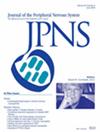Genetic and Clinical Features of 10 Families With Hereditary Sensory Neuropathies
Abstract
Background and Objectives
Hereditary sensory neuropathies (HSNs) are a group of genetically and clinically heterogeneous diseases. Our study aims to summarize the genetic and clinical features of HSNs in 10 Chinese families.
Methods
Clinical data from 10 families with HSNs were collected retrospectively. Genetic screening was performed by whole exome sequencing (WES). Repeated-primed PCR and capillary electrophoresis were performed for WES-negative patients to analyze repeat expansions in RFC1.
Results
Among the 10 probands with HSNs, eight cases were sporadic, and two had a positive family history. Six probands had early-onset (onset age < 20 years). Seven probands presented with pure-HSNs type, and three exhibited HSNs-complex type with ataxia. Variants in the NTRK1, SPTLC1, COX20, PUM1, and RFC1 genes were detected in six probands. A novel variant, c.444C>A (p.N148K), in NTRK1 was identified in an autosomal recessive inheritance family with HSAN-IV, and a novel variant, c.182dup (p.H61Qfs*31), in PUM1 was identified in a proband with adult-onset paresthesia and mild cerebellar ataxia. Additionally, biallelic expansion of the pathogenic variant structure (AAGGG)exp repeat amplification in the RFC1 gene was identified in a proband with sensory neuropathy, ataxia, and right vestibular hypofunction.
Conclusions
The novel variants in NTRK1 and PUM1 expanded the genotypic spectrum of HSNs. This study highlights the associations between sensory neuropathies and other symptoms, particularly cerebellar ataxia. Given the ultra-rarity of HSNs, future multicenter studies with larger cohorts may facilitate the identification of novel variants, improve genetic diagnostic rates, and enhance disease recognition.

 求助内容:
求助内容: 应助结果提醒方式:
应助结果提醒方式:


